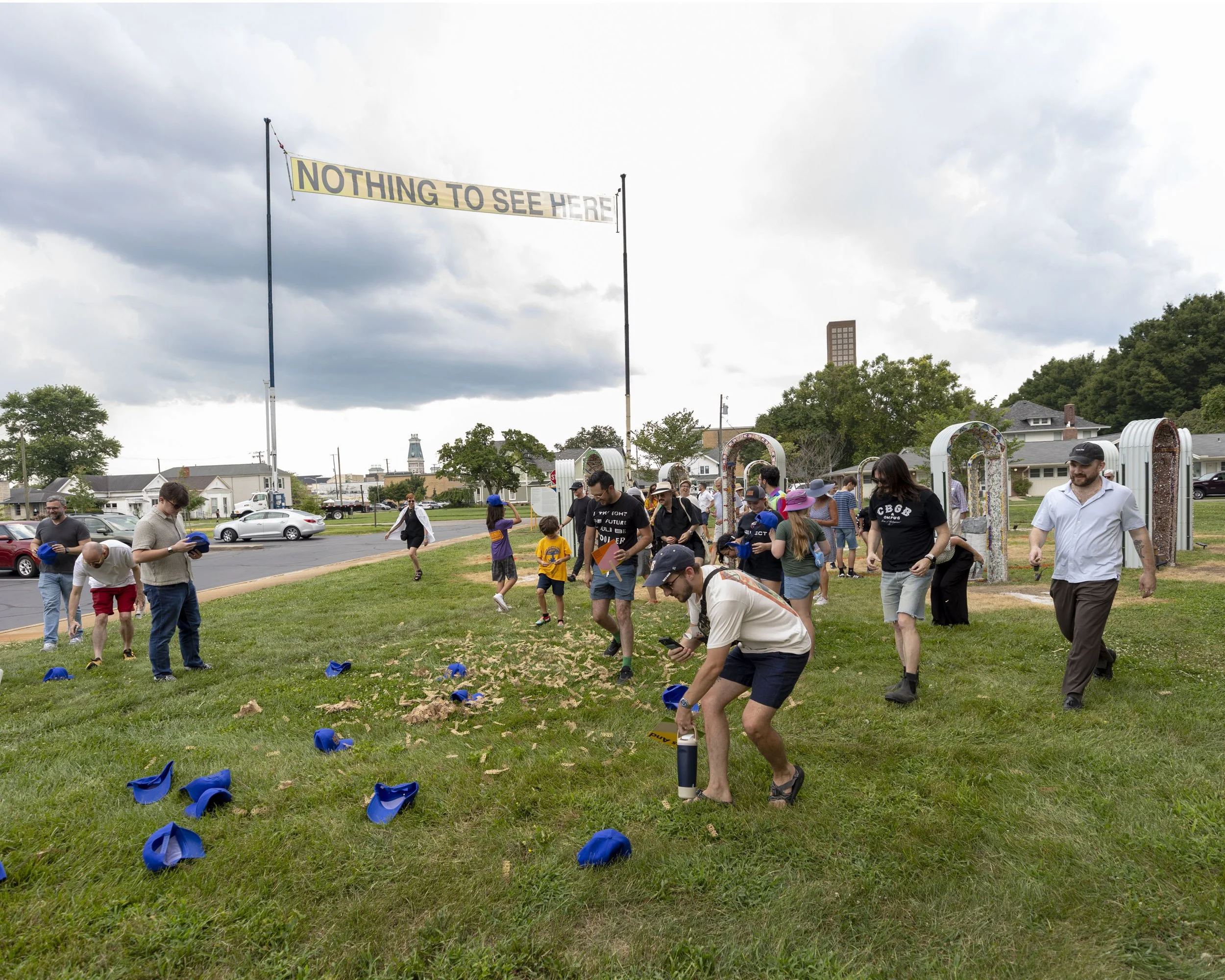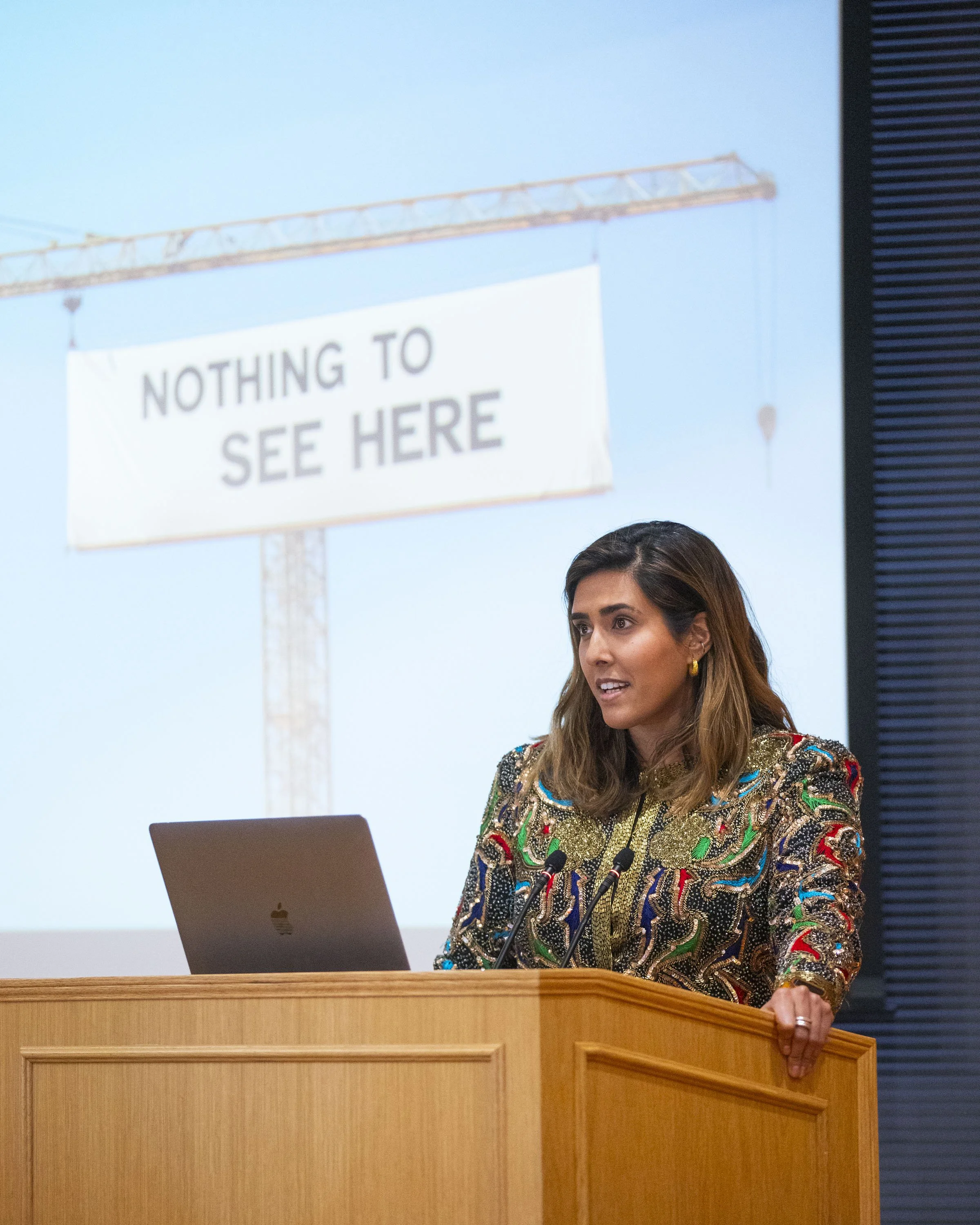University Design Research Fellowship
A View of the World from Indiana by Sarah Aziz
View of the World from Indiana highlights how the American Midwest has long served as an integral, yet under-recognized, foundation for a coastal design discipline. With the highest concentration of architecture fellowships in the United States, the region has often been perceived as a place where scholars venture early in their careers before returning to the coasts. Yet with 44 schools of architecture, 19 fellowships, and several internationally acclaimed cultural institutions—such as the Walker Art Center and Graham Foundation—the “Flyover States” are unquestionably spaces of emergence.
The installation comprises twelve “bathtub Madonnas”—one for each Midwestern state—that pay homage to the region’s outsider art traditions and architects often considered anathema within the architectural community. Above them, a massive banner reading “NOTHING TO SEE HERE,” designed to be visible from passing planes for two days during Opening Weekend, amplifies the Midwest’s derision in contemporary architectural discourse.
At its core, the project asks: Who do we valorize in architecture, and why? Who is “inside”? And who is “outside”? Why is the Midwest dismissed as flyover country, despite being a training ground for elite academics and a testing site for architectural experimentation? What do we owe the places—and people—we build on, with, and for? Through humor, irony, and historical reflection, View of the World from Indiana reclaims the Midwest’s place in the architectural imaginary, reminding us that to overlook this region is to overlook the conditions that continue to shape much of the field’s most progressive, brilliant works.
Location: Albuquerque, New Mexico
University: University of New Mexico School of Architecture and Planning
Commuity Partner: Columbus Propeller, Inc.
Site: St. Peter’s Lutheran Church
Site Accessibility: A View of the World from Indiana was only on view during Opening Weekend.
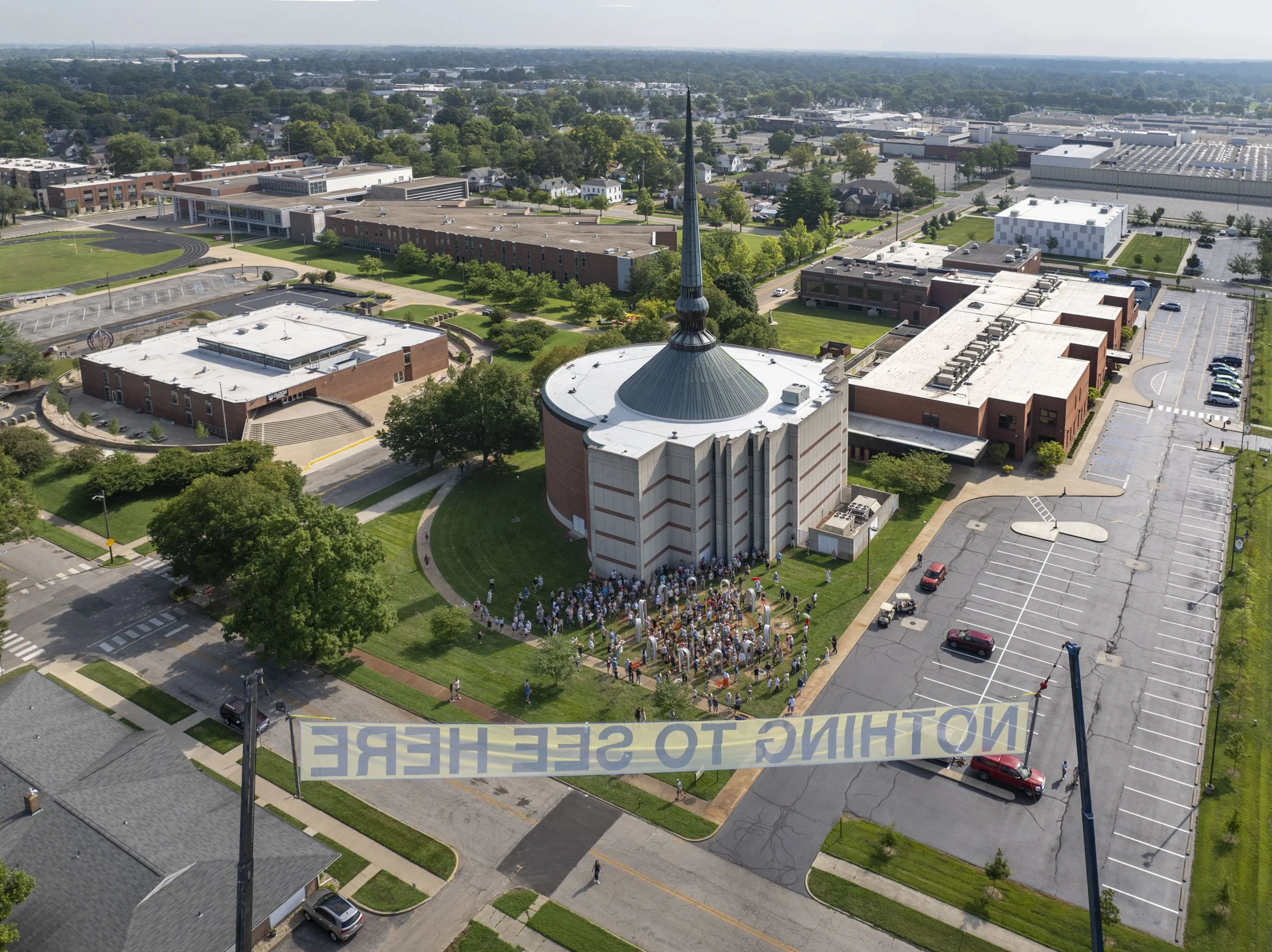
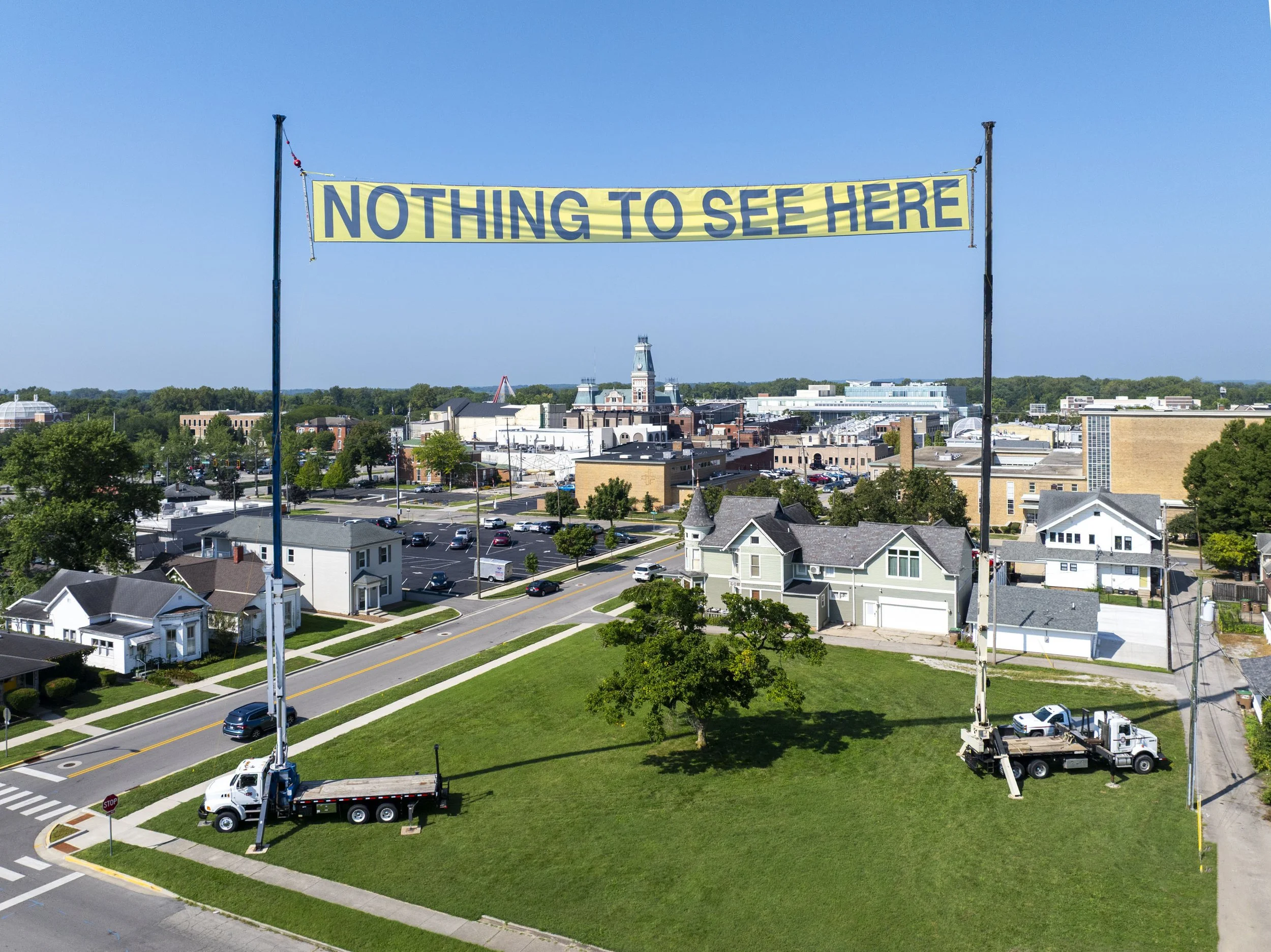
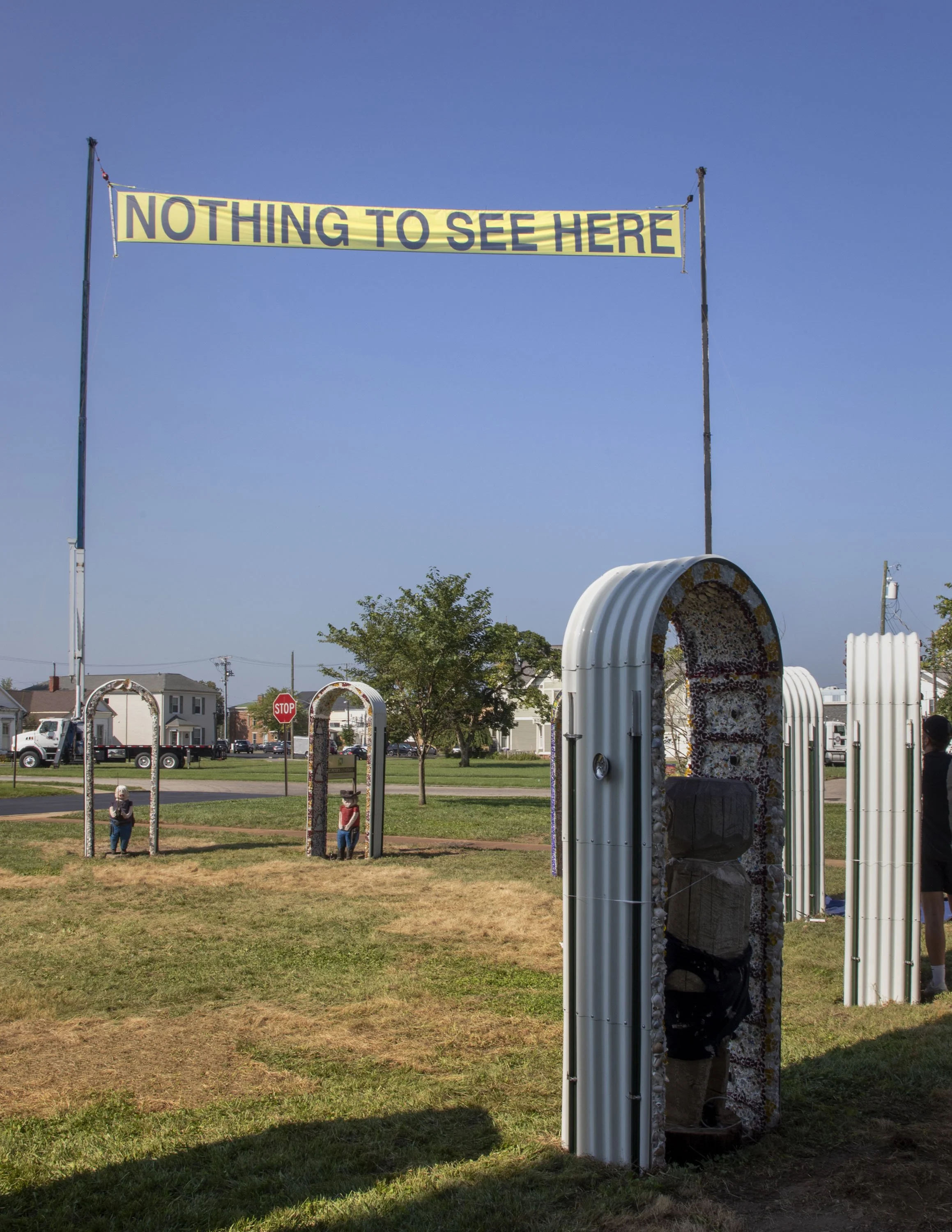
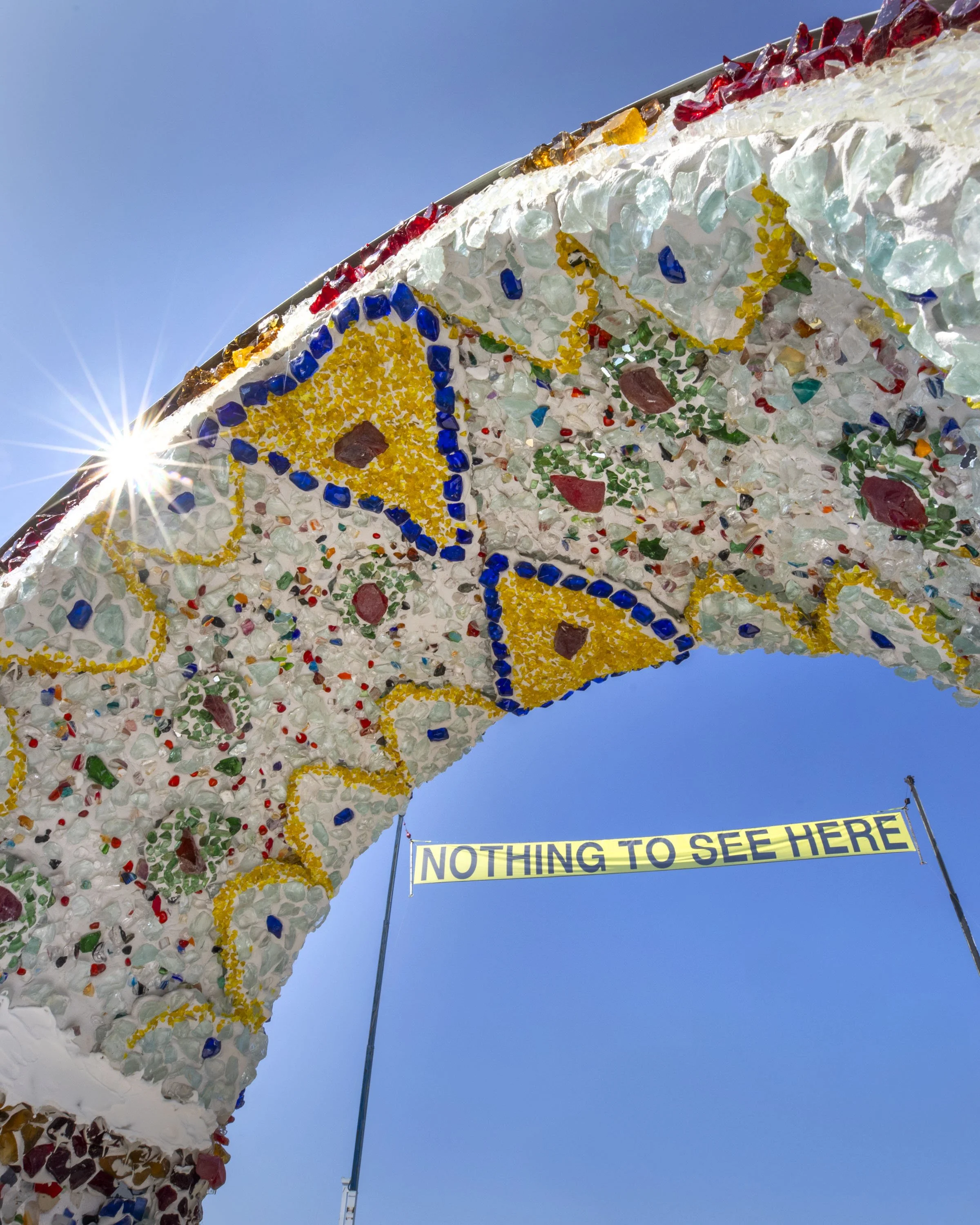
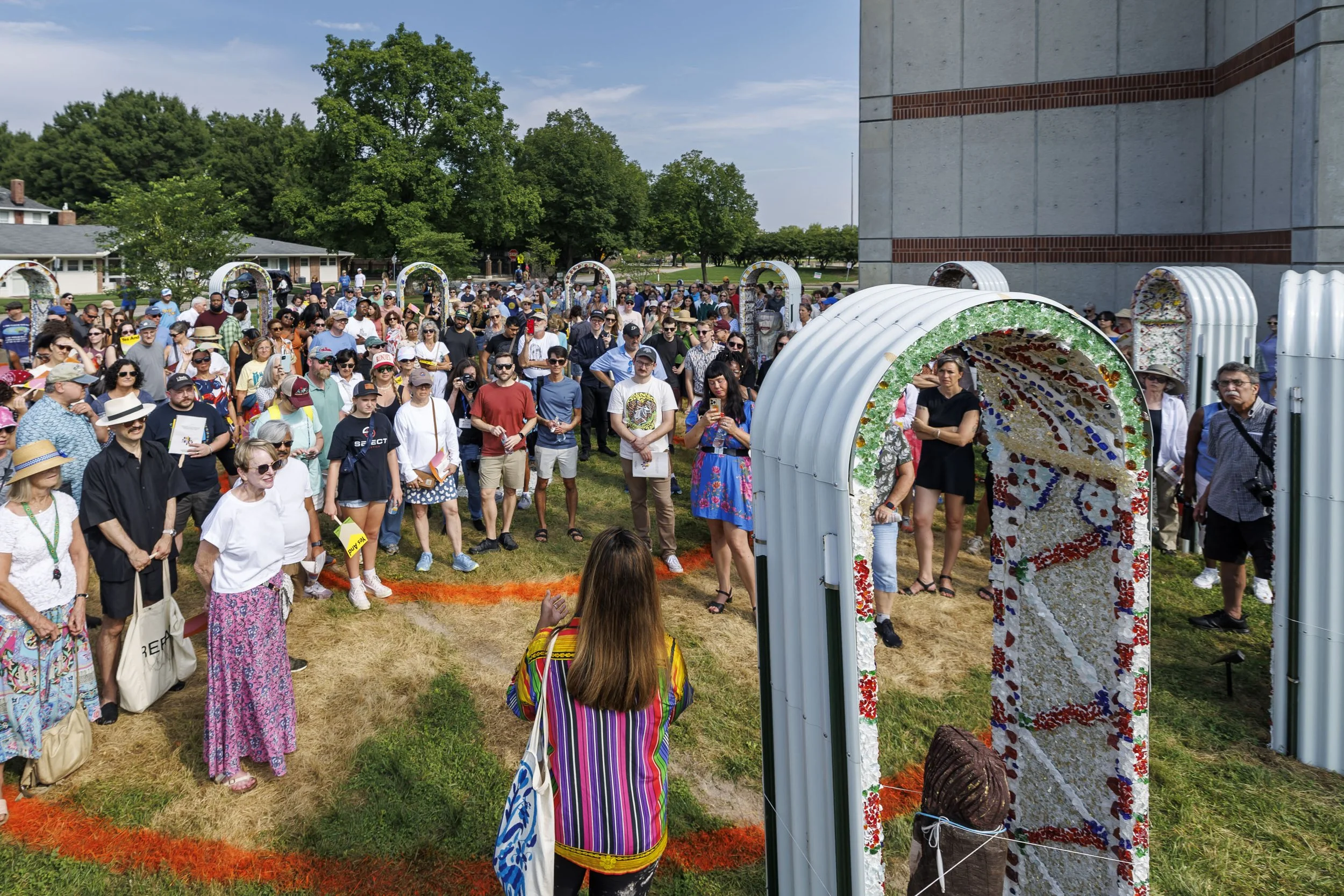
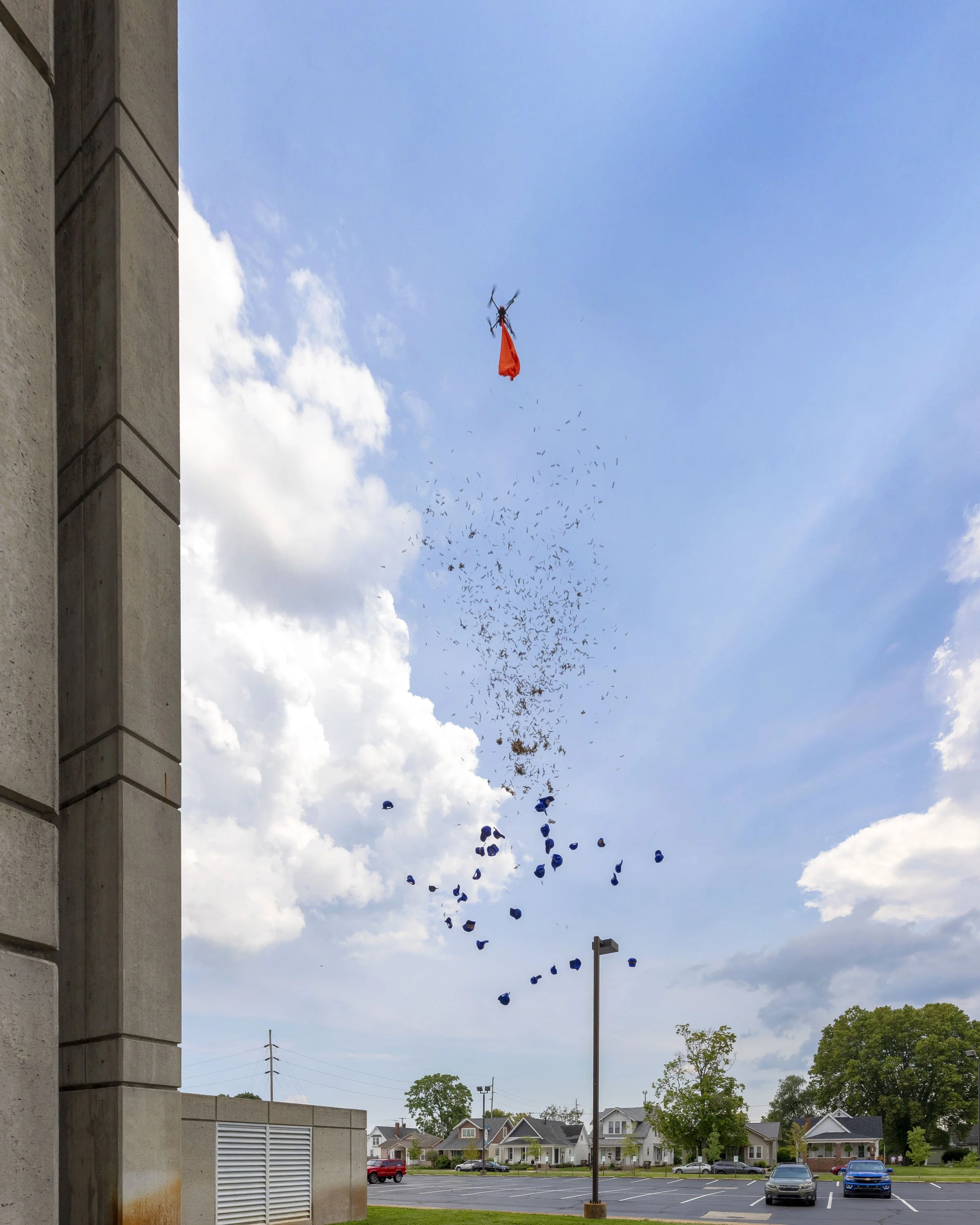
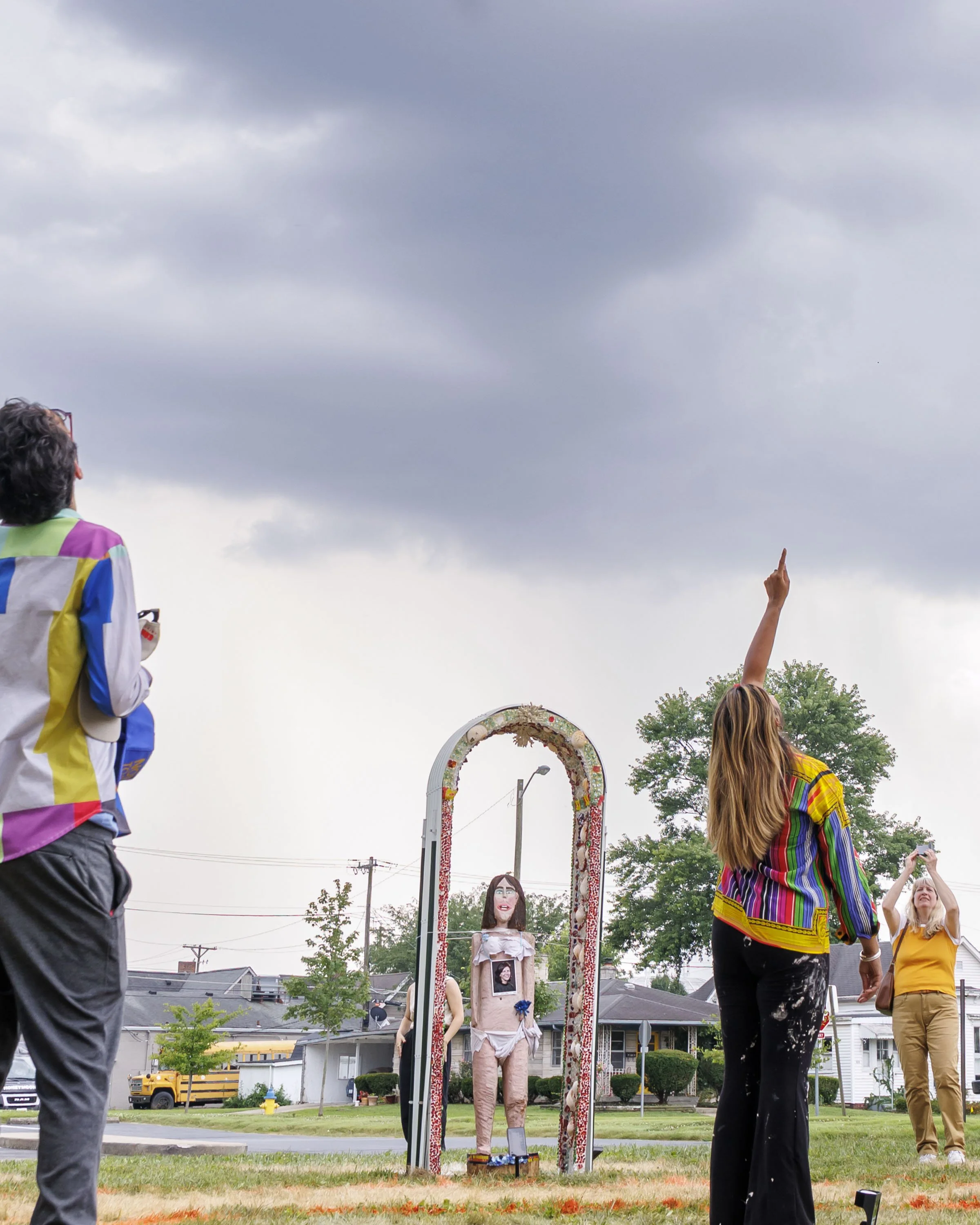
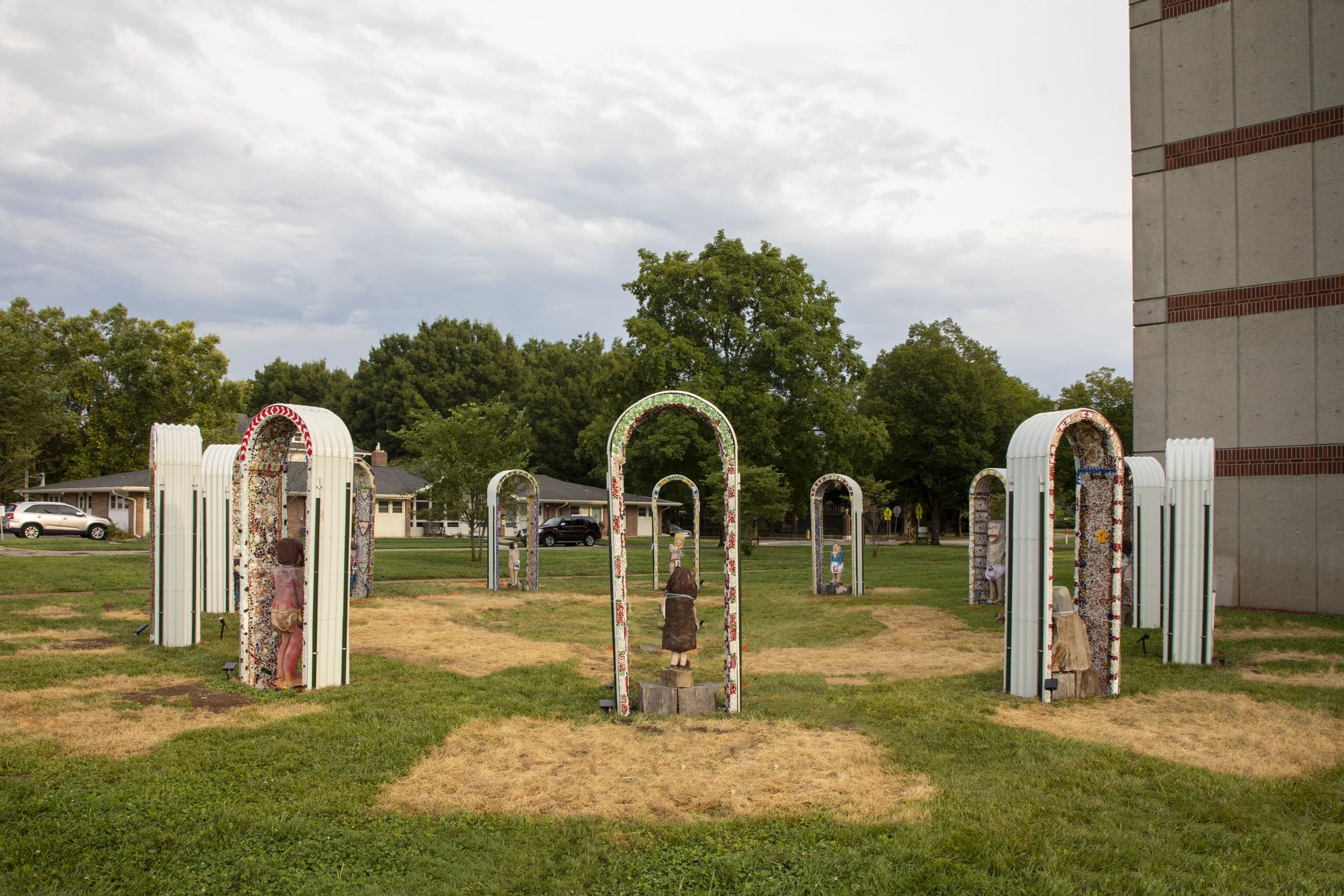
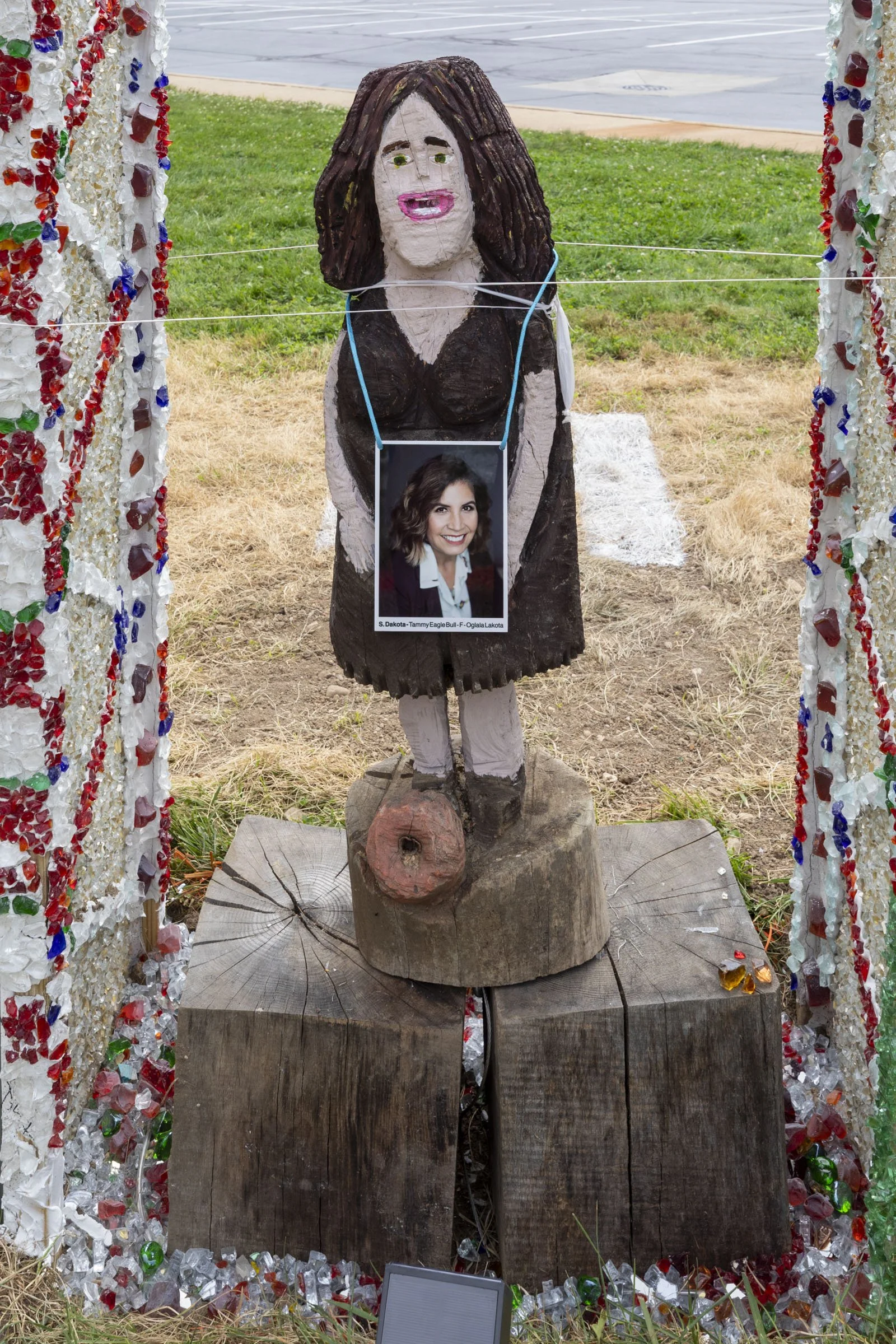

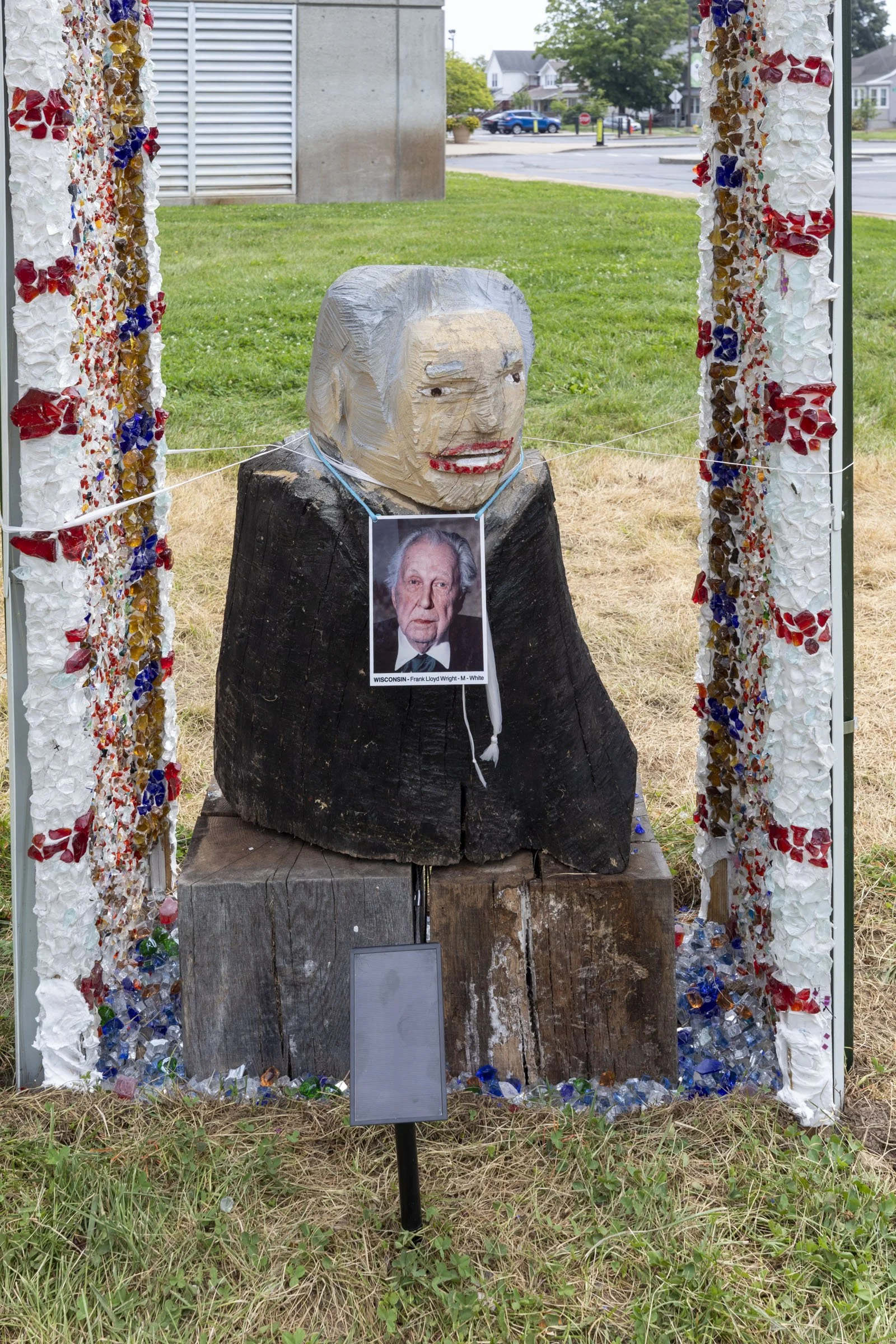
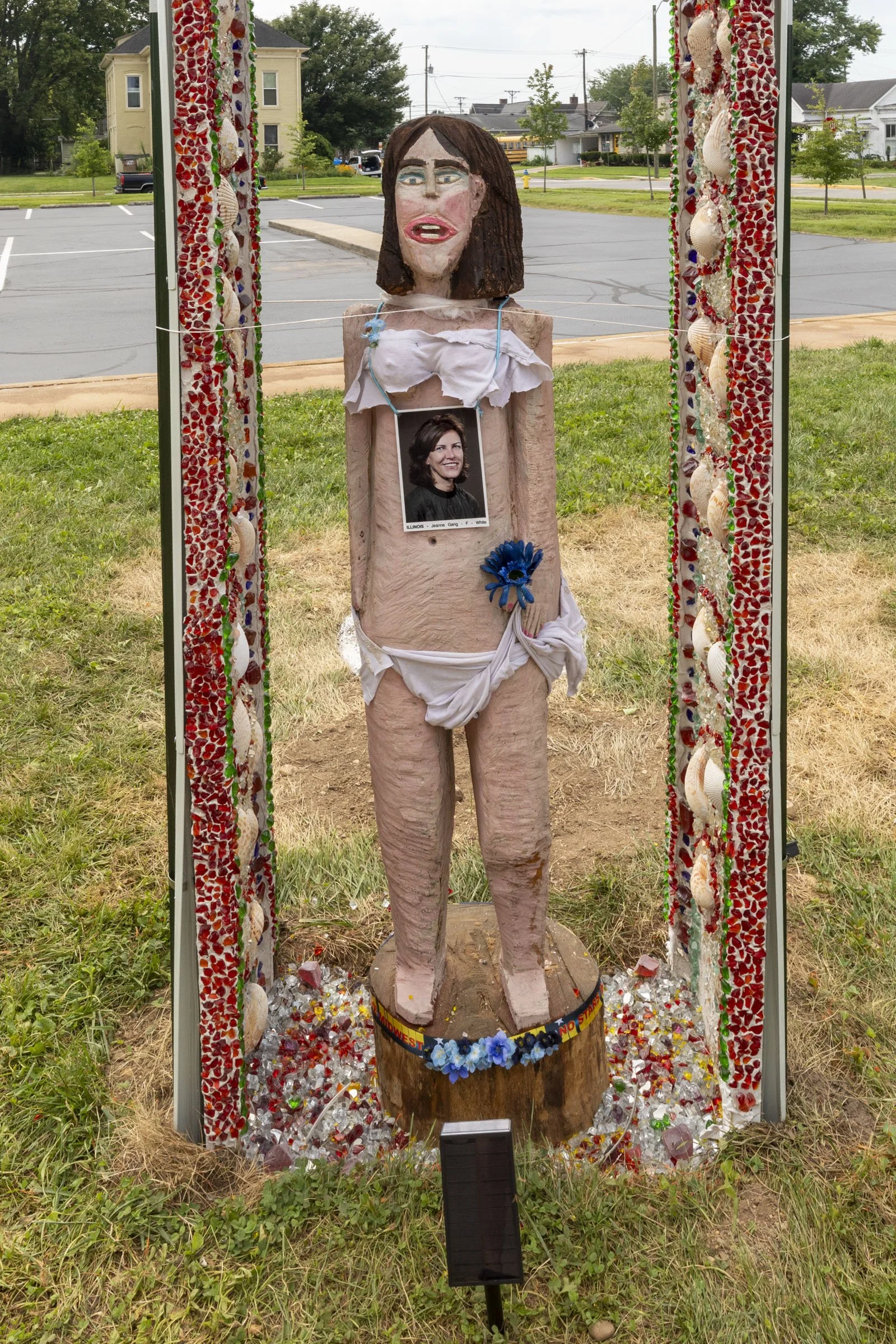
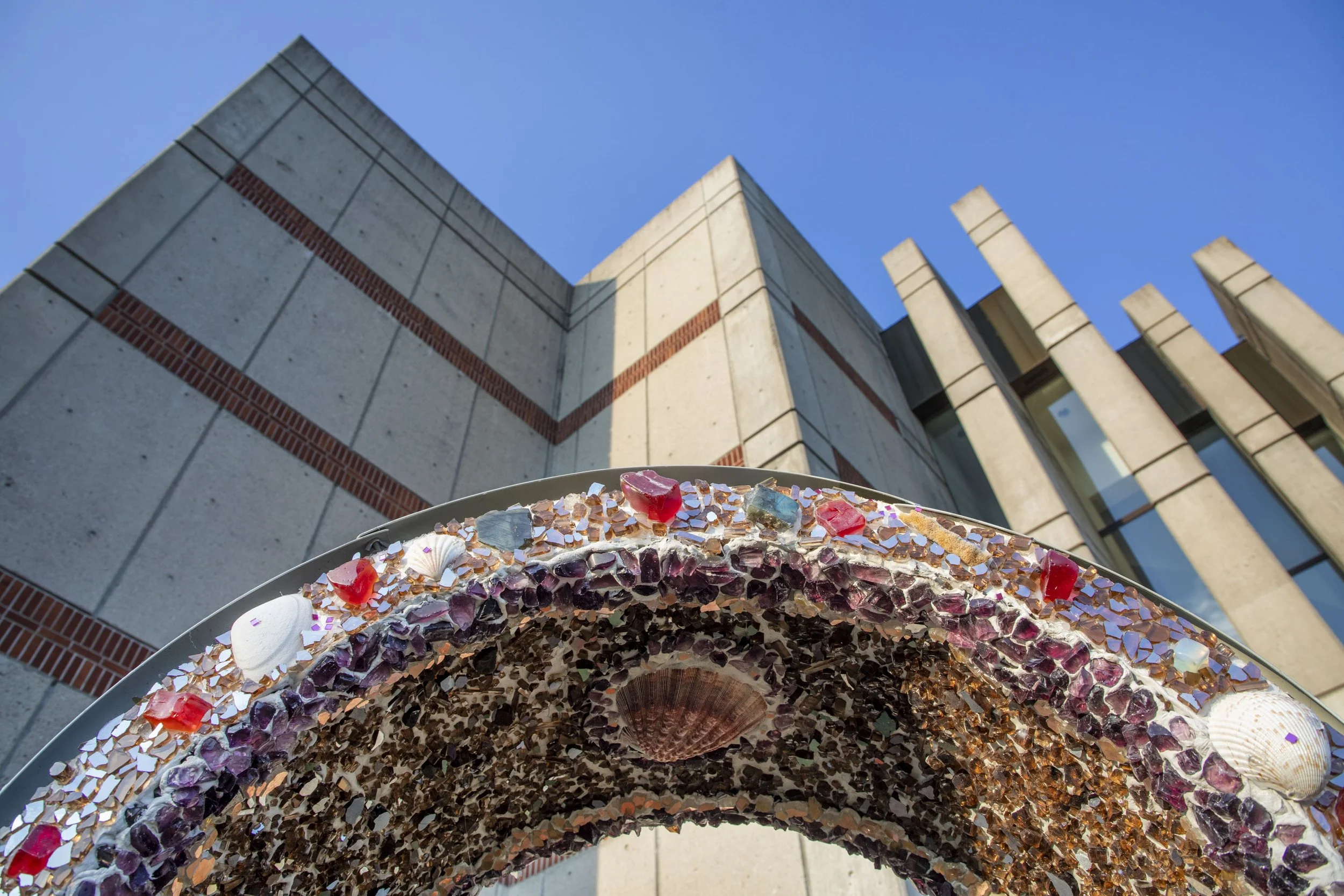
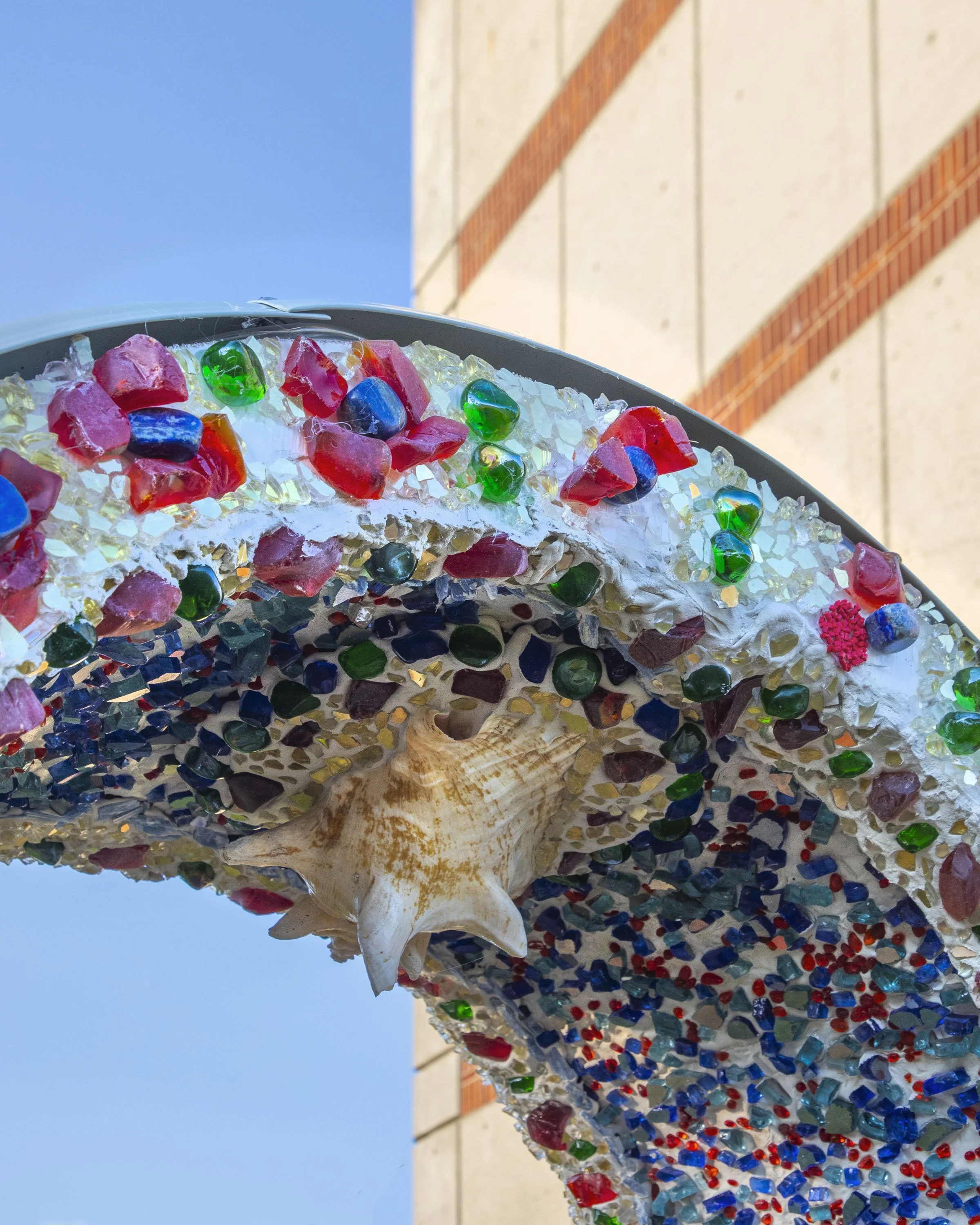

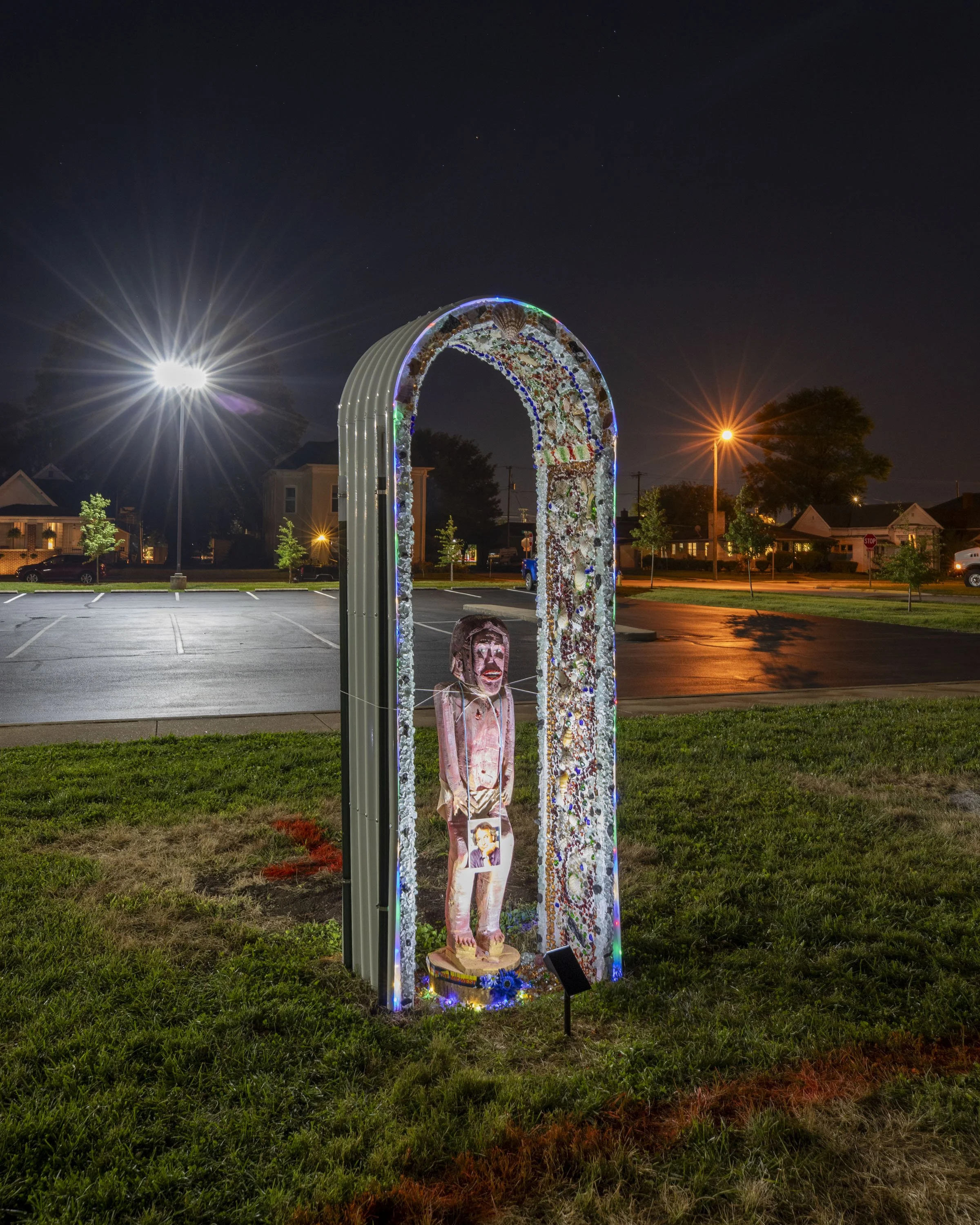
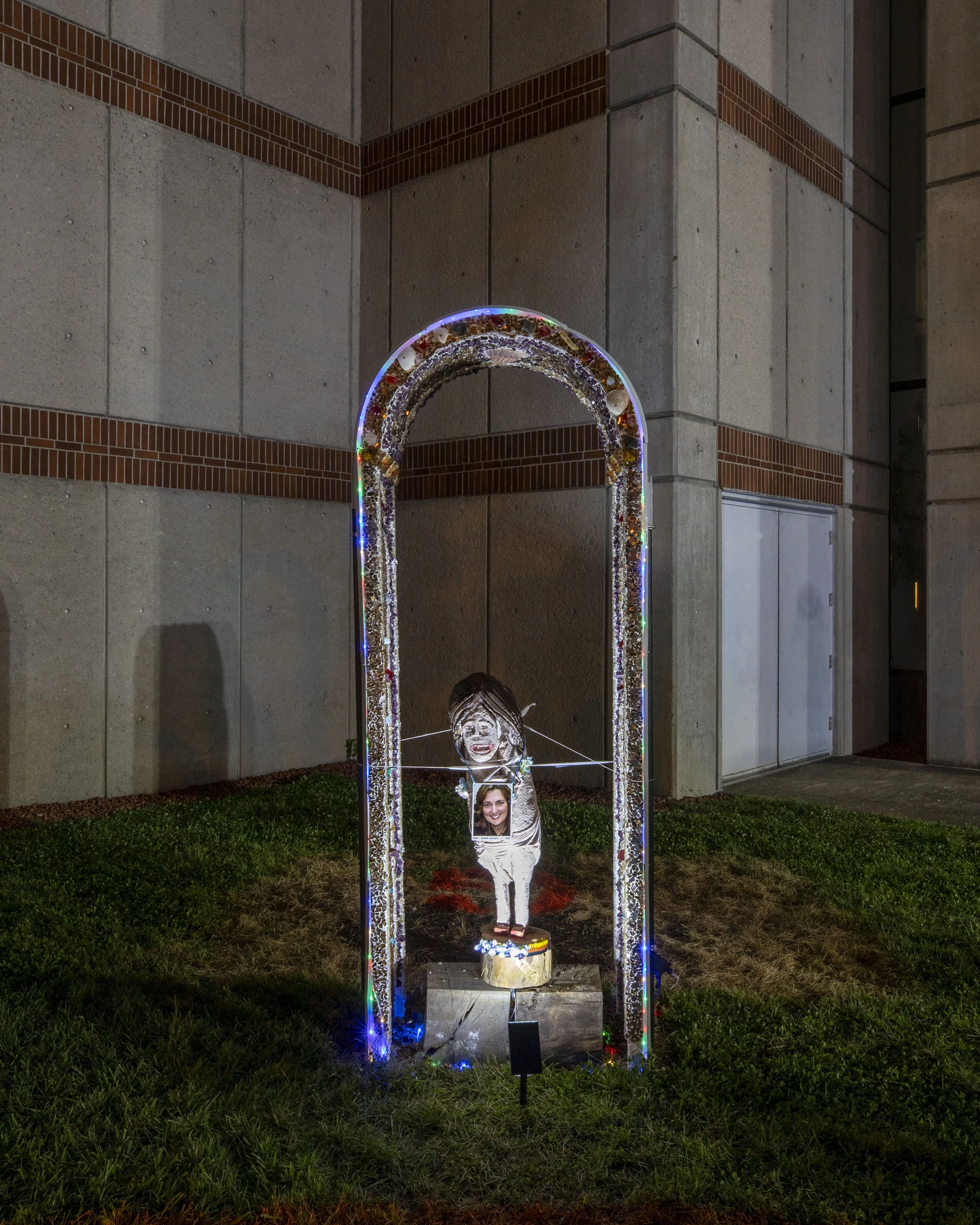
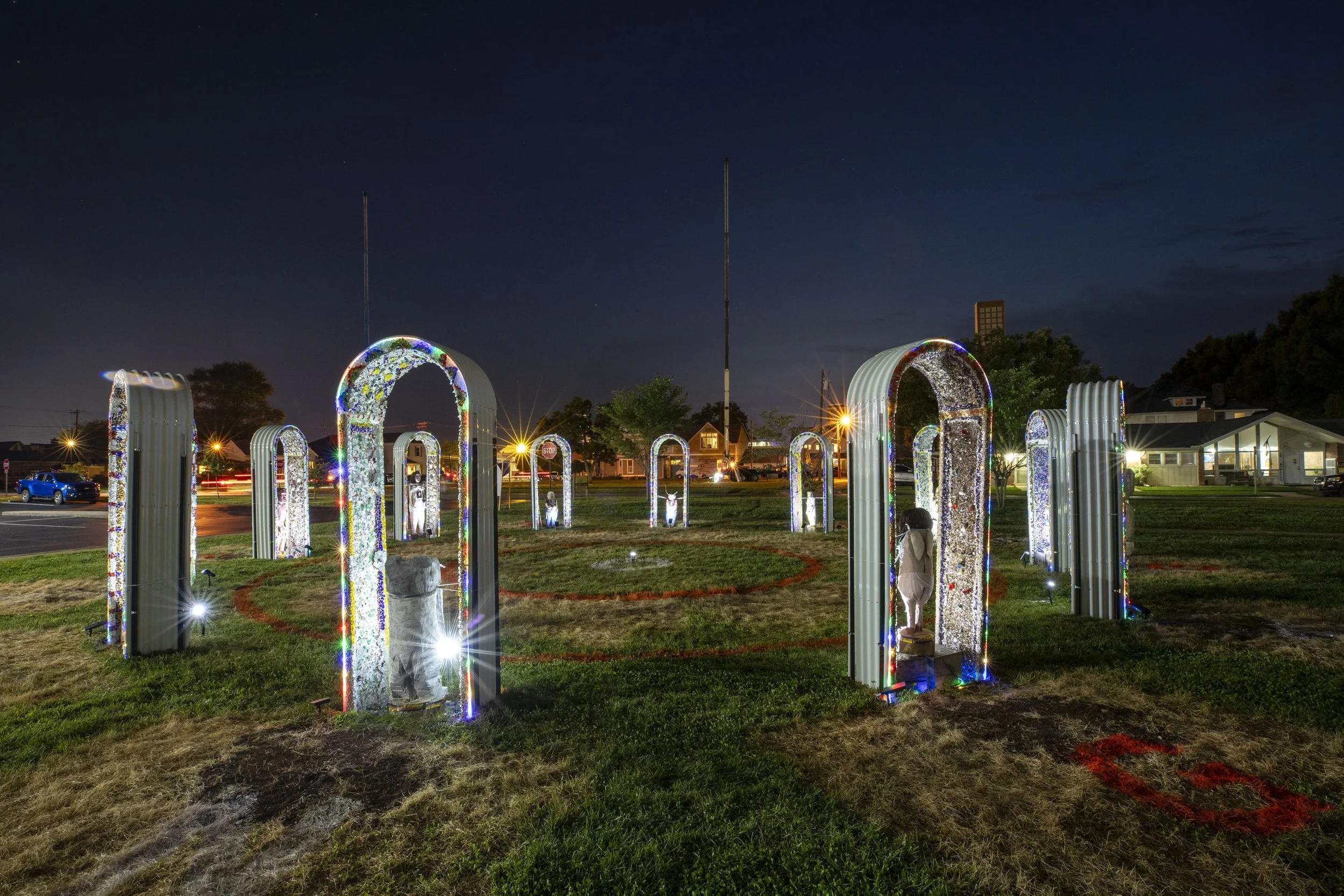
Presented by
Johnson Ventures
Site and Partner
St. Peter’s Lutheran Church
Partner
Columbus Propeller, Inc.
Materials
PVC plastic, Glass, Grout, Wood, Shells, Coral, Corrugated aluminium
Team
Steve Carner, Ben Nicholson, Sarah Aziz
Fabrication Support
Donnie Martin, Keith Nunnally
Additional Support
Amanda Fruits, Shannon Corrigan, Tom Guggenheim, Mary Beth Guard, Jaycob Keisel, Ben and Caroline Nicholson, Laura Foster Nicholson, Bonnie and Chuck Minette, Griffin Norman, Luna, Alex Palma, Ana Skolnik, The Town of New Harmony, IN, University of New Mexico
Learn more and watch the short animated video of A View of the World from Indiana.
Installation Credits
Sarah Aziz is an Assistant Professor of Architecture at the University of New Mexico. Her background as a second-generation British Pakistani informs her research practice that maps patterns of migration across multiple scales and geographies, starting with her grandfather’s walk from Delhi to Lahore during the Partition of British India. Currently, she is working with collaborators from across the Great Plains to tag, track, and build with tumbleweeds because they defy human-made borders and ask new questions of indigeneity and invasiveness. She holds a B.Arch. from Liverpool John Moores University and an M.Arch. from the School of the Art Institute of Chicago.
2025 Exhibition Field Guide
Interview with Sarah Aziz
Sarah Aziz, a professor at the University of New Mexico, has lived in Wisconsin, previously studied at the Art Institute in Chicago, and traveled widely throughout the Midwest. That being the case, she has always been puzzled by why the architecture in this part of the country hasn’t been more celebrated.
“The fact that some of the biggest architects of our time have started their careers here is of no small importance,” she said. “I’ve been slowly collecting the names of everyday buildings in each of the Midwestern states, where those who have been trained in architecture can see that the aspirations of the architect were much grander than what has been produced. Because of the nature of the building—a Walgreens or municipal building, for example—it has never been looked at closely by the architectural community.”
To answer her own question and correct the situation, she created a project titled Nothing to See Here: A huge banner that can theoretically be seen by people in planes above the “flyover states” will wave above the installation for Opening Weekend. But if she wants to attract people’s attention to this area, why did she choose that name?
“‘Something to see here’ doesn’t create desire,” she said. “But when someone says ‘Nothing to see here’ or 'Don’t look at this,’ you want to look at it far more than if someone had given you the green flag.”
The installation, she said, highlights the fact that the Midwest has long been a critical yet overlooked infrastructure for producing architectural discourse on America’s coasts.
A lover of folk art, Aziz decided on that medium to make her point.
“The Midwest is one of the richest landscapes for folk art in all of the United States,” she said. “I have seen lots of homemade, DIY shrines often placed in gardens across the United States but predominantly here in the Midwest. These are often upturned bathtubs with virgin Madonnas inside of them.”
Instead of Madonnas, however, the shrines she has constructed are to infamous architects from the 12 Midwestern states. At its core, the project asks: Who do we valorize in architecture, and why? Who is “inside”? And who is “outside”? Why is the Midwest dismissed as flyover country, despite being a training ground for elite academics and a testing site for architectural experimentation? What do we owe the places—and people—we build on, with, and for?
To address these questions, she used everyday, off-the-shelf materials such as raised garden planters and fire pit glass to create tubs/shrines with ordinary exteriors and extraordinary interiors. She engaged two Midwestern artists, Steve Carner and Ana Skolnik, to develop materials to adorn and fill the tubs. Carner chainsaw-carved the 12 Midwestern architects and Skonlnik transformed the colors, flags, and quilt squares from each state into new flags. Aziz’s fascination with detailed patterns and architectural “bling” was sparked by Loy Bowlin, the “original Rhinestone Cowboy,” who bejeweled his Mississippi home and just about everything he owned (including his dentures) with rhinestones.
“His obsessive attention to pattern and detail was something I wanted to bring into this work,” Aziz said. “Even though the budget is small and the scale is huge, the loss of detail doesn’t have to occur.”
She said she also respects and admires the creativity in the Midwest—the way people are able to use cheap, off-the-shelf materials to fashion highly customized things, which she said Bowlin exemplified. Inspiration also came from Alexander Girard, whose folk art she had seen at the International Folk Art Museum before she saw the collections he gathered for the Miller family.
The legacy of J. Irwin Miller and New Harmony’s Jane Blaffer Owen have also energized her work—their love for experimentation and the appetite for something new.
“Yes, my project is a little tongue-in-cheek,” she said. “But it pays homage to the brilliance of the Midwest. Maybe people who continue to believe there is nothing to see here can check their assumptions.”
2024 Symposium
University Design Research Fellows participated in a panel discussion about their work.
2025 Design Presentations
Sarah Aziz presented A View of the World from Indiana to a public audience at City Hall.

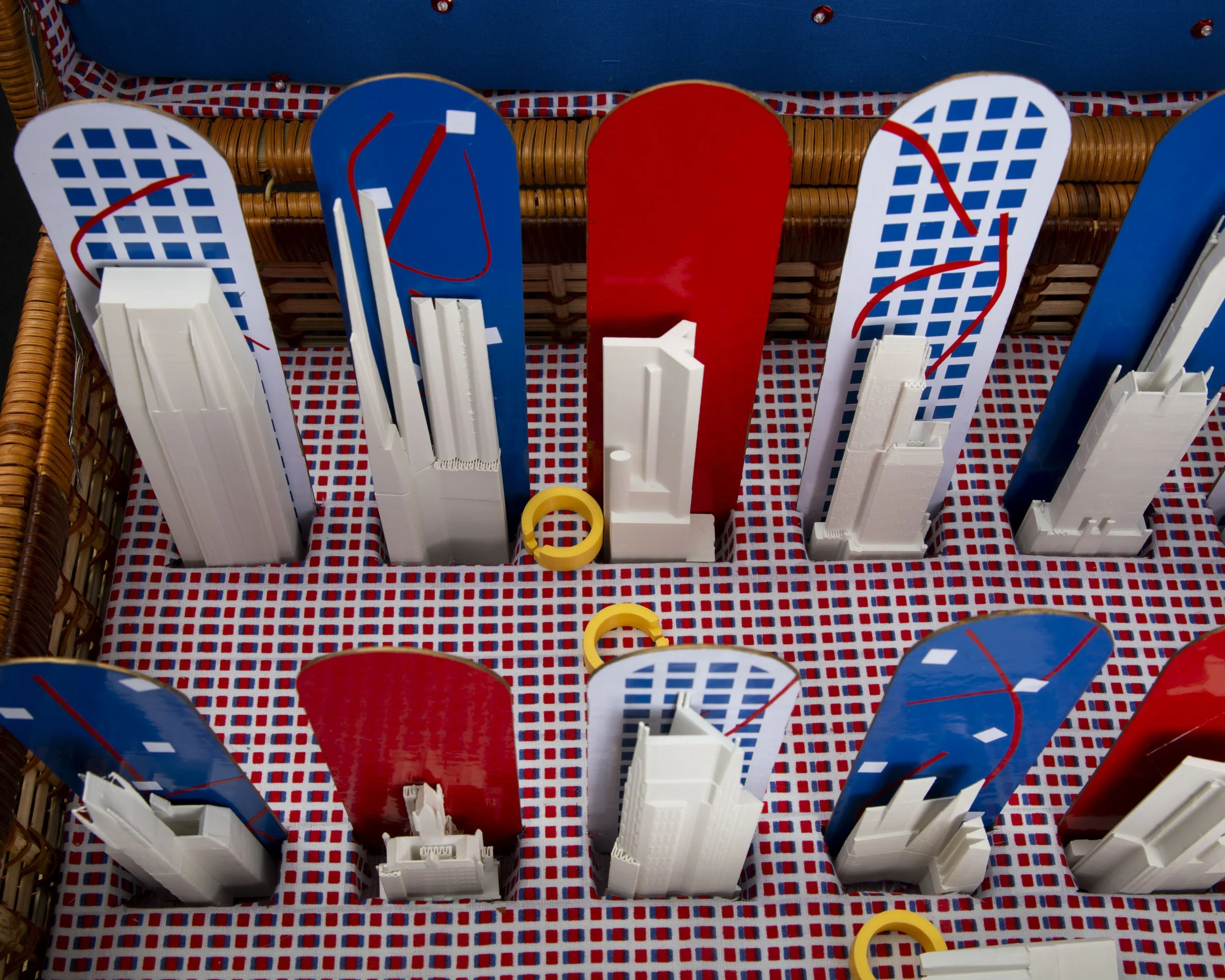
Previous Work by Sarah Aziz
Currently, Dollar General Corp—America’s largest small-box retailer—opens around 67 new stores a month, totaling 19,643 stores in the continental United States and Mexico. Dollar General often rents existing buildings that have a footprint under 10,000 sqft, allowing it to avoid the stringent permitting rules its big-box competitors like Walmart and Target face. It’s nimble, fast, and has quietly infiltrated American consumerism and the American landscape. Yet, despite being an “American” institution, most of its products come from Yiwu, a city of approximately 65 million people in the Zhejiang province of China. The project studies the retail empire’s transnational operations to identify the systems that have enabled the invasion of the dollar store empire, and asks: What would happen if architecture canonized overlooked building typologies and places? And what does it mean for architecture to contribute to the construction of a nation’s identity—at home and abroad? Research conducted in collaboration with Lindsey Krug.
A Day Late and a Dollar Short
Tumbleweed Rodeo
Tumbleweed Rodeo excavates and exhibits tumbleweed’s complicated legacies to identify how it helped construct a particular kind of American subjectivity in the Southwest. Through impromptu, Dadaesque performances, design-build projects, and GPS-informed landscape drawings, the Rodeo asks new questions of indigeneity and invasiveness: who came first, and who’s really invasive? The plant intersects everything from President Thomas Jefferson’s efforts to create a nation of yeoman farmers to President Herbert Hoover’s control over wheat prices in World War I and Georgia’s steppe biome degradation during the Russo-Georgian War. By tracing tumbleweeds’ movement from their place of origin to their host country, the slow commercialization and banalization of America’s Southwestern landscapes come into high relief.
During the pandemic, I collaborated with artist and farmer Eric J. Simpson on a 750’-long landscape drawing. We attached GPS trackers to tumbleweeds and released them across Eric’s farm in Shallowater, Texas. Peculiarly, the tumbleweeds’ paths were always contrary to the Jeffersonian grid—the 18th-century rectangular land survey system used in the early US Republic to displace Indigenous peoples. We selected one vector, and Eric and his team hand-sewed thousands of native seeds along it. It grew to be around 10’ tall, and Eric held dinners and dérives inside while students documented the conversations and events. Gradually, migratory birds consumed the drawing.
The Lubbock installation was made in collaboration with Jack Craft.
Walk the Line
Over six consecutive days in September 2020, 110 architecture students from the University of Wisconsin-Milwaukee circumnavigated Milwaukee’s boundary on foot, by bike, and by car to experience firsthand how the city both affects and is affected by race, class, and climate change. The studio, Walk the Line, functioned as a traveling repository and production line operating from the periphery of the city to survey the intersection between land, the human body, and human activity. By traveling 110 miles around the outermost edge of Milwaukee without ever crossing the imaginary line enclosing it, students understood the pervasive effects of environmental racism as issues that they could no longer ignore. Students cataloged their observations through field diaries and narrative maps, reflected on those annotations with people they met along the way and online, and collectively designed and built 34 site-specific interventions in response. The grass social distancing machine was made in collaboration with Natalie Kuehl.

